Hydrangea at Crocus
by Diane - July 12th, 2012.Filed under: Crocus.
A bold statement plant suitable for all borders in your garden. Big bright flowers that pack a punch. Cut and use the flowers in the house too!
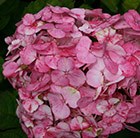
Hydrangea ‘Preziosa’ (hydrangea) £9.99
Position: full sun or partial shade Soil: moist, well-drained, moderately fertile, humus-rich soil Rate of growth: average Flowering period: August and September Hardiness: fully hardy Masses of mophead flowers start out deep pink in June, maturing to red with a crescendo of burgundy by the end of the year on neutral or slightly acidic soil . On acid soil, the flowers will open blue or mauve. This upright, deciduous hydrangea is a gorgeous specimen plant for a sunny or partially shady border where the purple-flushed foliage will add colour. It looks particularly good planted with other hydrangeas. The flowerheads are also a popular choice for dried flower arrangements. Garden care: Hydrangeas do not like to dry out. In dry weather, soak the roots with a hose and the plant will usually recover. Remove faded flowerh eads in spring after the danger of frosts, cutting back the flowered stems to a strong pair of buds. Take out misplaced or diseased shoots. Mulch young plant s with a well-rotted manure or compost in spring. Once established, remove a quarter to a third of the shoots to the base of the plant. Hydrangeas give their best blue flowers on acidic soil of pH 5.5. When grown on neutral soil, with a pH of 7, flowers will predominantly be pink, although blue or mauve blooms can also be produced. To produce blue blooms, make sure your soil is acidic with a pH of at most 6.5. To make a neutral soil acidic you can treat it annually with aluminium salts. However it’s much harder to alter the pH of limey soil (alkaline), so it’s easier to grow white or pink hydrangeas.
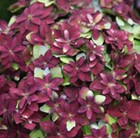
Hydrangea Expression (‘Youmesix’) (hydrangea) £9.99
Position: full sun or partial shade Soil: moist, well-drained, moderately fertile, humus-rich soil Rate of growth: average Flowering period: July to September Flower colour: pink (or blue on acidic soils) Other features: contact with the foliage may aggravate skin allergies; the flower-heads make excellent dried flower arrangements Hardiness: fully hardy One of the new breed of re-blooming hydrangeas, which will flower for far longer than many of the older types, but this is the first in its class to have double flowers. In good conditions, you should see the first flowers emerging in late spring or early summer, pink on neutral or alkaline soils and blue on acidic ones. They will then carry on appearing in big, rounded clusters, right up until the first frosts. More compact than many other mopheads, it is ideal for pots, where they can be used to provide summer-long colour to the patio, or place it in a prominent spot towards the front of a shrub border. Garden care:To enhance flowering prune in spring, cutting back the flowered stems to a strong pair of buds below each flower-head. Once established, remove a quarter to a third of the old shoots to the base of the plant.

Hydrangea anomala subsp. petiolaris (climbing hydrangea) £12.99
Position:sun to partial shade Soil:fertile, well-drained soil Rate of growth:slow at first, then medium Flowering period: early summer Hardiness: fully hardy Pruning: none required A star plant, this climbing Hydrangea thrives in some of the most shady, inhospitable areas of the garden. Slow to establish, it will eventually romp along a wall or fence, clinging by aerial roots. Its almost heart-shaped, dark green leaves turn yellow in autumn, and masses of showy, lacy, white flowerheads appear in late spring and early summer. Garden care: Plant in moist, fertile soil and do not allow the soil to dry out while the plant is getting established. This hydrangea flowers on the previous season’s wood, so if you need to prune it back, do so in late autumn or early spring, but be warned that this will restrict flowering the following year.
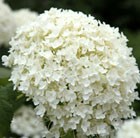
Hydrangea arborescens ‘Annabelle’ (sevenbark) £9.99
Position: full sun or partial shade Soil: moist, well-drained, moderately fertile, humus-rich soil Rate of growth: average Flowering period: July to September Hardiness: fully hardy One of the loveliest hydrangeas, this has huge globes of tightly packed, creamy white bracts that look like giant snowballs in late summer. As autumn progress es, the blowsy flowerheads fade to pale lime and the dark green, pointed leaves turn soft yellow. It has an upright habit and makes a breathtaking feature in a wide, partly shady border, particularly when planted in groups or with other hydrangeas. The flowerheads are a popular choice for dried flower arrangements . Contact with the foliage may aggrevate skin allergies. Garden care: Hydrangeas do not like to dry out. In dry weather, soak the roots with a hose and the plant will usually recover. Remove faded flowerh eads in spring after the danger of frosts, cutting back the flowered stems to a strong pair of buds. Take out misplaced or diseased shoots. Mulch young plant s with a well-rotted manure or compost in spring. Once established, remove a quarter to a third of the shoots to the base of the plant.

Hydrangea arborescens ‘Grandiflora’ (sevenbark) £14.99
Position: full sun or partial shade Soil: moist, well-drained, moderately fertile, humus-rich soil Rate of growth: average Flowering period: July to September Hardiness: fully hardy A summer flowering deciduous shrub, that bears large, rounded clusters of white flowers that have a greenish tinge when they first appear. It is invaluable for adding late colour to the summer garden and when planted en-masse, it can be used to make an interesting, informal hedge or screen. Contact with the foliage may aggrevate skin allergies. Garden care: Hydrangeas do not like to dry out. In dry weather, soak the roots with a hose and the plant will usually recover. Remove faded flowerh eads in spring after the danger of frosts, cutting back the flowered stems to a strong pair of buds. Take out misplaced or diseased shoots. Mulch young plant s with a well-rotted manure or compost in spring. Once established, remove a quarter to a third of the shoots to the base of the plant.
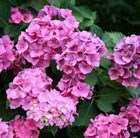
Hydrangea macrophylla ‘Altona’ (mophead hydrangea) £9.99
Position: full sun or partial shade Soil: moist, well-drained, moderately fertile, humus-rich soil Rate of growth: average Flowering period: July and August Flower colour: rich pink (dark purple-blue on acid soils) Other features: contact with the foliage may aggravate skin allergies; the flower-heads make excellent dried flower arrangements Hardiness: fully hardy Large heads of rich-pink to dark purple-blue flowers from July to August and coarsely toothed, dark green leaves. This compact, hortensia hydrangea is perfect for where border space is limited. Best in partial shade, on neutral soils a ‘blueing compound’ may be applied every 7-14 days to produce blue flowers. Garden care:To enhance flowering prune in spring, cutting back the flowered stems to a strong pair of buds below each flower-head. Once established, remove a quarter to a third of the old shoots to the base of the plant.
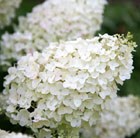
Hydrangea paniculata ‘Silver Dollar’ (hydrangea) £14.99
Position: full sun or partial shade Soil: moist, well-drained, moderately fertile, humus-rich soil Rate of growth: fast-growing Flowering period: August to September Flower colour: creamy-white turning pink with age Other features: the flower-heads make excellent dried flower arrangements Hardiness: fully hardy Dense trusses of creamy-white flowers open from the base of the spike from midsummer to early autumn and gradually become pinker as they age. Ideal for adding late colour to the shrub border. Garden care:To enhance flowering prune hard in early spring, cutting back the previous season’s shoots to within a few buds of the permanent, woody framework of the plant.

Hydrangea paniculata ‘Unique’ (hydrangea) £13.99
Position: full sun or partial shade Soil: moist, well-drained, moderately fertile, humus-rich soil Rate of growth: fast-growing Flowering period: August – October Flower colour: white fading to pink Other features: the flower-heads work well in dried flower arrangements Hardiness: fully hardy This beautiful cultivar is very similar to H. paniculata ‘Grandiflora’, but it has larger flowerheads and slightly more vigorous growth. Its name refers to the unique shape of the flower clusters, which are very broad at their base and rounded at the tip. Each white flower is reasonably large and will develop pink tones as they age. It can be trained to form a single stemmed specimen, but it is more commonly grown as a multi-stemmed shrub. It will provide lashings of late summer and autumn colour, and can even be used to form an informal, flowering hedge. Garden care:To enhance flowering prune hard in early spring, cutting back the previous season’s shoots to within a few buds of the permanent, woody framework of the plant.
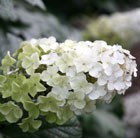
Hydrangea quercifolia Snow Queen (‘Flemygea’) (oak-leaved hydrangea) £13.99
Position: full sun or partial shade Soil: moist, well-drained, moderately fertile, humus-rich soil Rate of growth: average Flowering period: July to September Hardiness: fully hardy A fantastic hydrangea, with bright green leaves shaped like giant oak leaves and large cones of white flowers in late summer. In autumn, the leaves turn dramat ic shades of coral, pink and red, and the flowers fade to pale pink, then brown. A fabulous shrub that gives its best for most of the year. It’s best in the m iddle of a partially shady border, and associates beautifully with most other hydrangeas. Garden care: Hydrangeas do not like to dry out. In dry weather, soak the roots with a hose and the plant will usually recover. Remove faded flowerh eads in spring after the danger of frosts, cutting back the flowered stems to a strong pair of buds. Take out misplaced or diseased shoots. Mulch young plant s with a well-rotted manure or compost in spring. Once established, remove a quarter to a third of the shoots to the base of the plant.
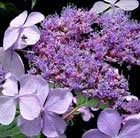
Hydrangea serrata ‘Bluebird’ (hydrangea) £9.99
Position: full sun or partial shade Soil: moist, well-drained, moderately fertile, humus-rich soil Rate of growth: average Flowering period: June to September Hardiness: fully hardy Flattened heads of beautiful, blue-mauve flowers last from June to September and in autumn, the pointed, mid-green leaves, turn dusky red. On alkaline soils th e flowers may become pink. This compact, deciduous hydrangea is perfect for small gardens in sun or partial shade. Hydrangeas give their best blue flowers on acidic soils with a pH 5.5. When grown on neutral soil, (with a pH of 7), the flowers will predominantly be pink, although you may also get blue or mauve blooms. If you want to make sure that your Hydrangea has blue-toned flowers, you will need to make sure your pH does not creep above 6.5. To lower the pH on a neutral soil, you can treat it annually with aluminium salts. It’s much harder however to alter the pH of limey (alkaline) soil, so it’s much easier to grow white or pink hydrangeas instead. Garden care: Hydrangeas do not like to dry out. In dry weather, soak the roots with a hose and the plant will usually recover. Remove faded flowerh eads in spring after the danger of frosts, cutting back the flowered stems to a strong pair of buds. Take out misplaced or diseased shoots. Mulch young plant s with a well-rotted manure or compost in spring. Once established, remove a quarter to a third of the shoots to the base of the plant.






